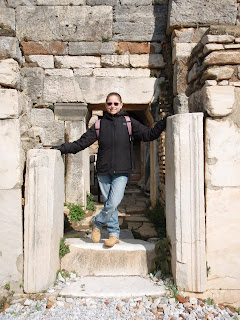 |
| South east side of Amelia's wall |
Editor's Note: James Alex Bond, ARCA Class of 2011, arrived a month before the commencement of the program in Amelia. ARCA Blog asked him to contribute a post about his impressions.
by James Alex Bond, Amelia Correspondent
Amelia’s geography is just stunning. It sits on the northern end of a ridge that runs north and south with the north end of the ridge approximately 1,000 feet higher than the southern end. Every direction except south is a 60-80 degree slope downhill to the valley floor below where the Rio Grande River flows on the north and east side. I would guess that less than 3,000 people live within the walls of Amelia with the other 9,000 living in the surrounding hillsides.
Amelia is shaped like a big egg with its small end at the south where virtually all traffic enters and exits through Porta Romana which is faced by Piazza XXI Setembre directly outside the wall. There are three other Portas, two on the east side and one in the north west corner but Porta Romana is the commercial Porta to the city. During the day there is always a traffic jam at Porta Romana because it is barely the width of a car. Entering and exiting vehicular traffic alternate while intrepid pedestrians turn sideways and slip in and out, or wait for a break in the traffic flow when there is confusion as to who has the right of way. It is all very civilized and I have yet to hear anyone honk their horn. It is a small city where everyone knows everyone. The one show stopper is a Mother with a perambulator going through the Porta. Talk about tiger Moms, Italian Moms can stop a car with just a stare!
From the small end of the egg at Porta Romana, via della Republica heads north uphill into the city until it reaches the highest point in town where the Torre Civica (tower) is located in Piazza Lojali. Near the Piazza (open square) there is a small grassy area with a walkway around the edge for the magnificent views to the north, east, and south. From there you can see the other mountain ranges that rise up behind the cultivated hills surrounding Amelia.
There are eight Piazza’s in Amelia. They contain statuary, fountains, and space for parking. The balance of the town is roads, pathways, or buildings. The wall surrounding the town is fairly intact and still has guard towers built into it. I have tried to do a walk around the city just outside the wall but found that, at least on the east and north side, it was impossible because of the steepness and lack of a trail. The other day I did find a trail on the south east side that I followed out to a rocky promontory where I could watch the sunset. The picture I have included is of the wall on the south east side. I did not follow the trail past the promontory but suspect it connects to the road I had followed previously around the east and north side. That is my adventure for next week, to circumnavigate the city below the wall.
Visually the city is a blend of gray and brown, with red tile roofs and copper gutters. The piazza’s are a blend of greens, reds, and yellows depending on the plantings. Many people have gardens where you can see trellises with climbing vines and flowers. Outside the walls on the surrounding hillsides it is completely different with olive and wine orchards and cultivated fields interspersed with copses of woods and green pasture land.

One of my favorite things to do here is sit in my garden, close my eyes, and focus on what I hear. Birds singing predominate, with soft wind sounds in the trees as a background. Then hourly and on the quarter hour the domo bells ring. Three times this morning a unique two bell melody was played for about a minute from the domo, calling the faithful. I think this melodic bell ringing happens every Sunday. It is such a beautiful change from the perfect recorded bells played from the campanile and carillon bell towers in the US. The first two times the melody was the same. The third time it was different and the bell pullers got off rhythm. In my mind I could almost see them as they realized their rhythm was off and communicated either visually or verbally about what to do to correct it. Soon they did and in the end it seemed to me they improvised, and, like good jazz musicians, finished winners. The talent it takes to take two bells and play a unique melody reminds me of the Blue Man Group with their ability to percuss about anything and make it sound pleasing. Eighty feet below my wall I can hear the sounds of traffic on the road to Tearny.
Favala, my contact for the school, said she had slowly come to see the different areas of the world as either masculine or feminine after taking a trip to Israel and Palestine. The desert is masculine she said. “You have to be tough to survive. You just don’t go out for a walk in the desert. You make a plan, take supplies, and prepare yourself for hardships.” Italy she said is different “because it is feminine.” And so I have found it to be; soft, graceful, forgiving, fecund, and welcoming. You do not have to make a plan in Amelia you just have to be present.
 Chasing Aphrodite,getty aphrodite,Libya,rutelli,Sicily,Venus
Chasing Aphrodite,getty aphrodite,Libya,rutelli,Sicily,Venus
 No comments
No comments
 Chasing Aphrodite,getty aphrodite,Libya,rutelli,Sicily,Venus
Chasing Aphrodite,getty aphrodite,Libya,rutelli,Sicily,Venus
 No comments
No comments













